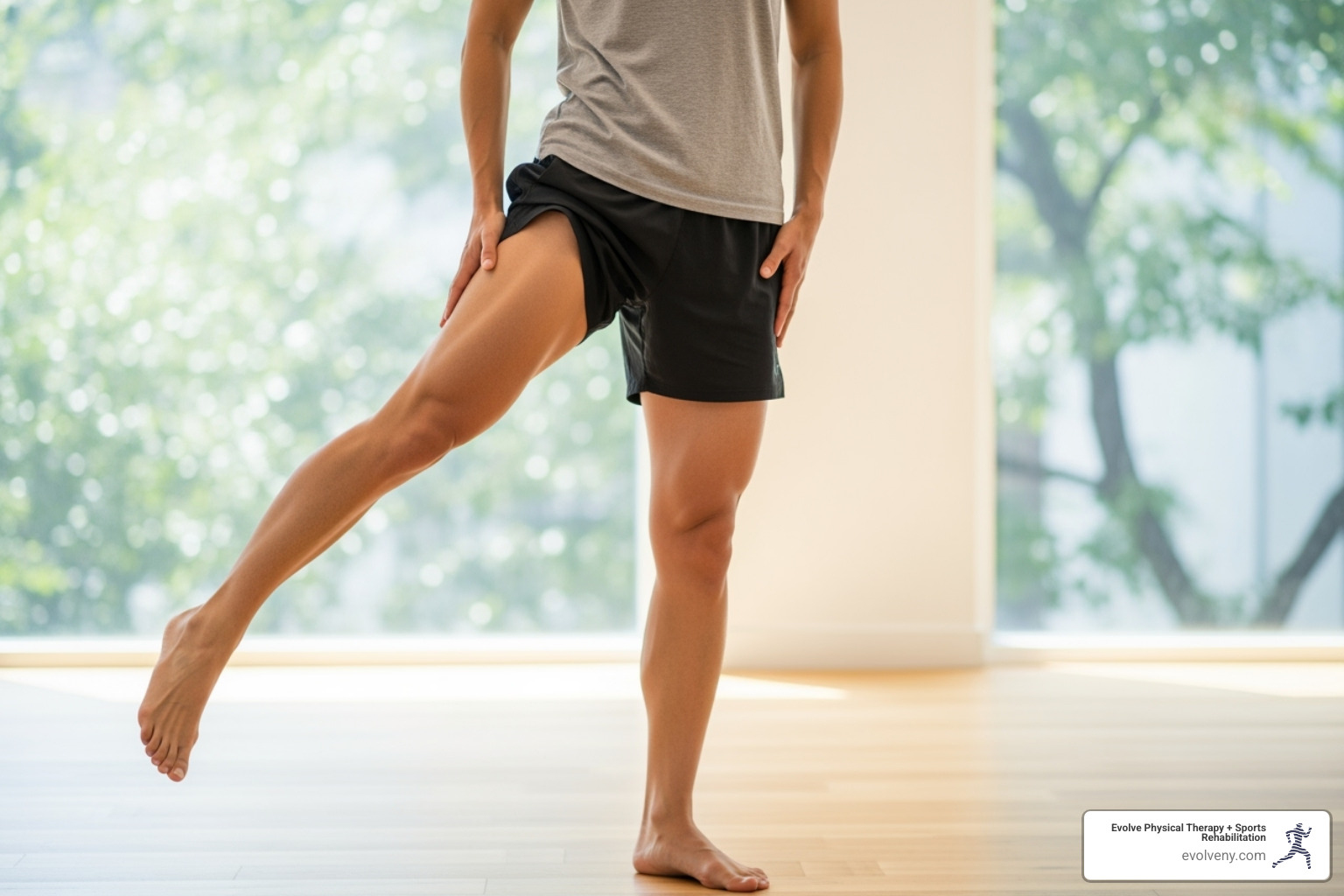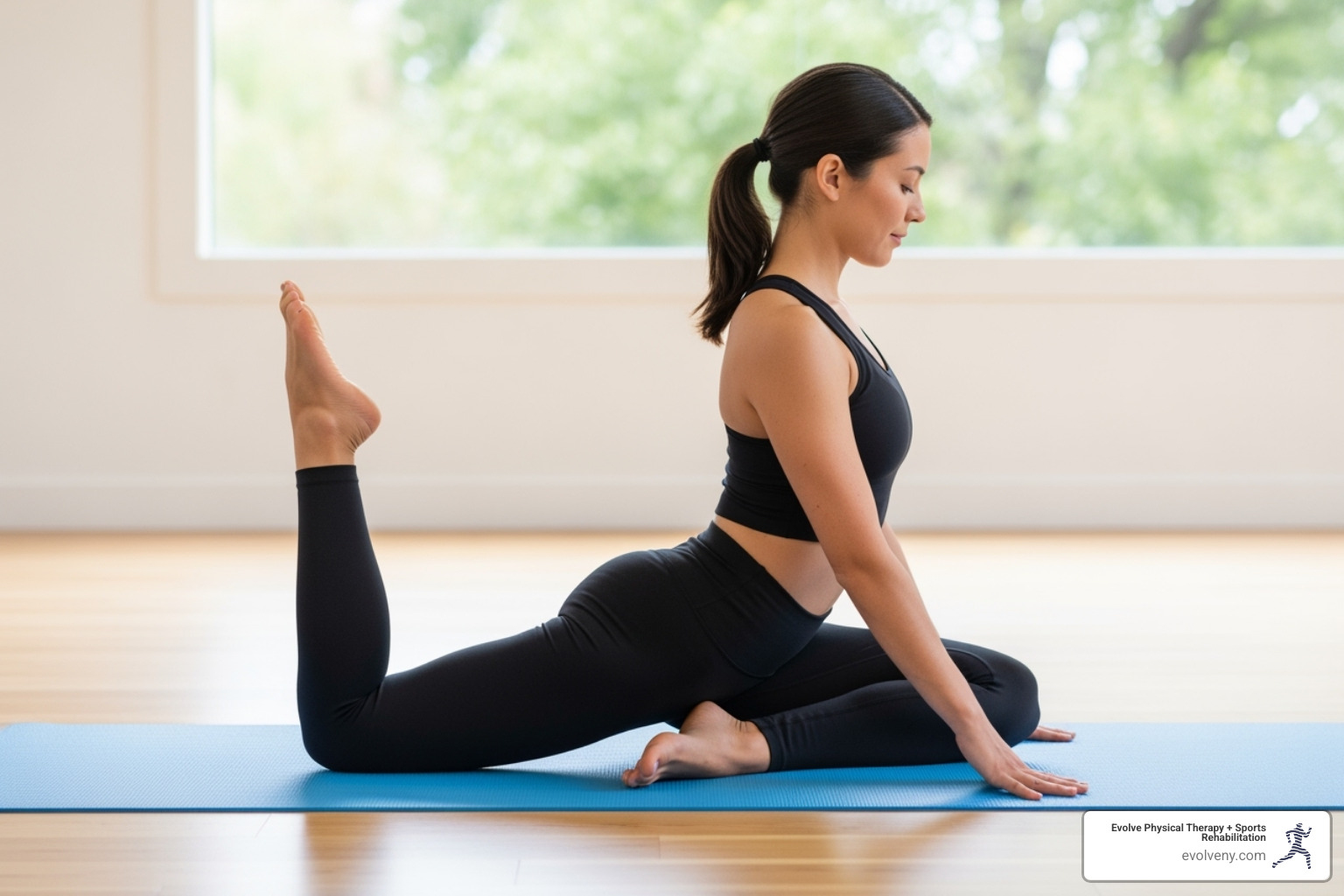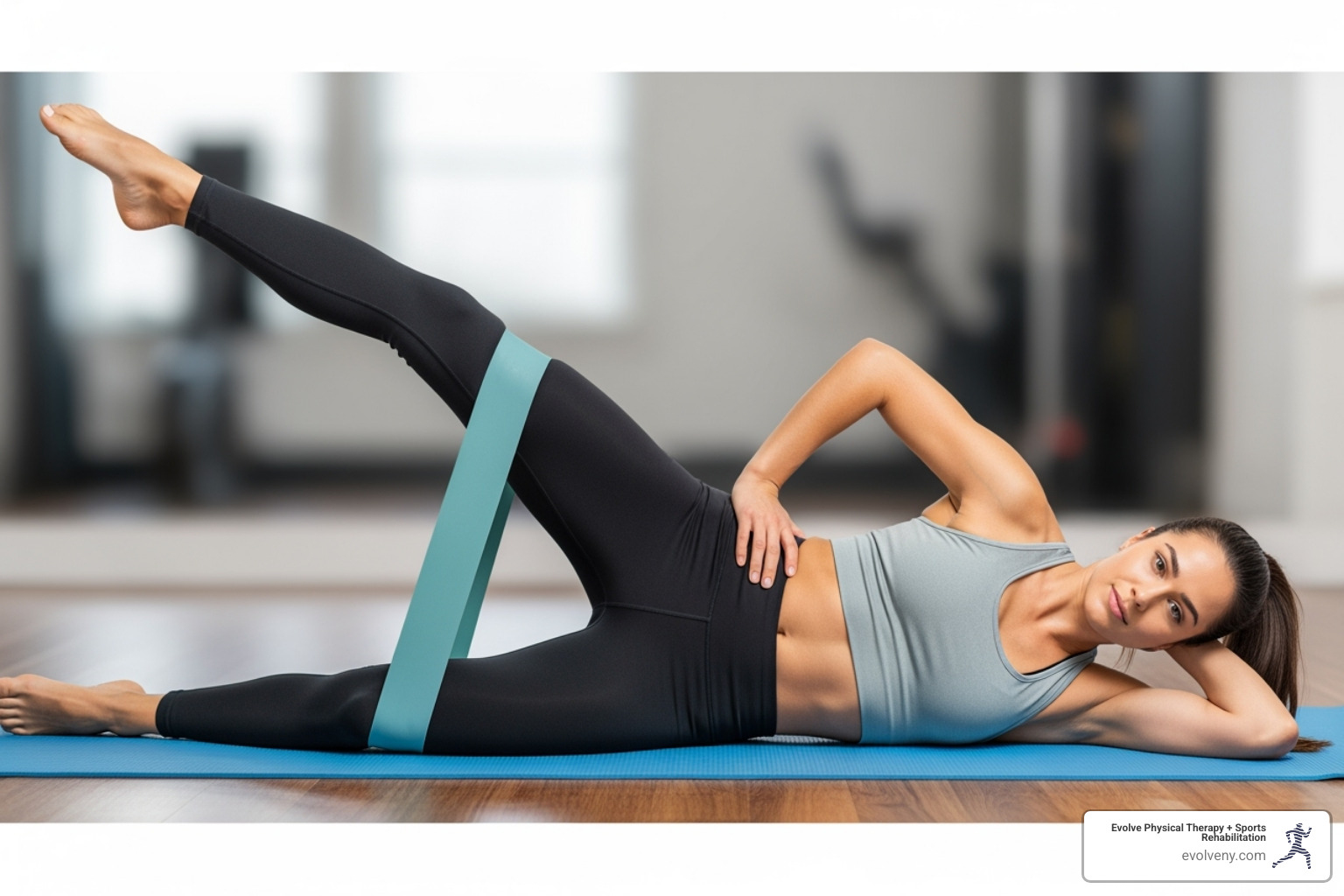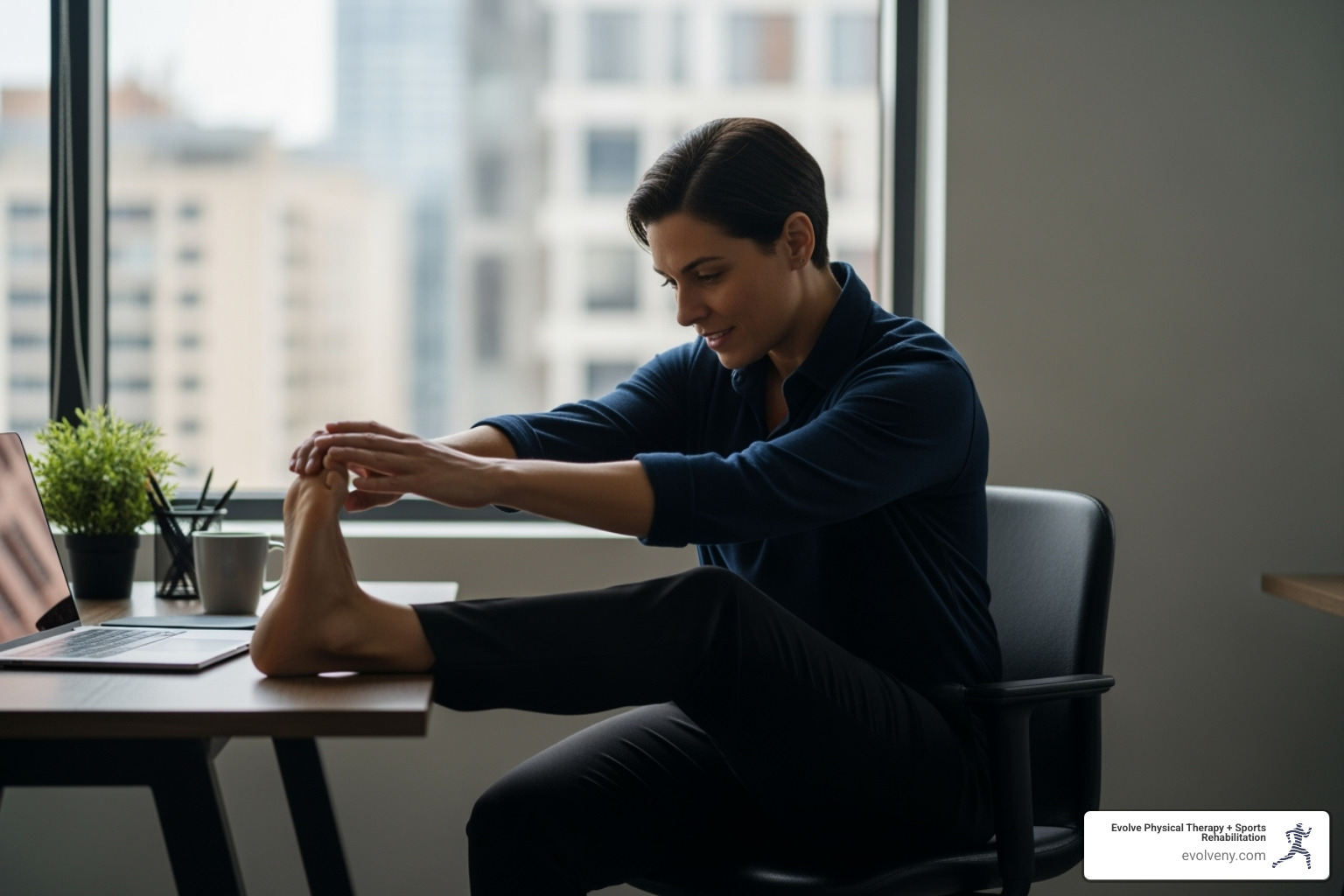Rotate Your Way to Better Hip Mobility
Why Hip External Rotation Mobility is Key to Movement

If you're wondering what hip external rotation mobility is, here's a quick breakdown:
- What it is: The outward turning of your thigh and knee, away from your body's center. Think of standing and turning your toes out.
- Why it's important: This movement is crucial for everyday actions like stepping sideways, getting in and out of a car, or kicking a ball. It stabilizes your hips during walking and running and can reduce strain on your knees and lower back.
- Key muscles: The primary muscles include your gluteus maximus, the piriformis, and several smaller, deep hip muscles called the "deep six rotators."
Have you ever seen a pitcher throw a baseball? That powerful motion relies on strong, mobile hip external rotators. Or maybe you've felt nagging knee pain after a run or lower back stiffness from sitting too long. Often, the root cause links back to your hips.
Poor hip mobility, especially in external rotation, can undermine your daily activities and athletic performance, contributing to discomfort and injury. The good news is, you can improve it.
As Louis Ezrick, a physical therapist with nearly two decades of experience, I’ve seen how improving hip external rotation mobility transforms lives. My work at Evolve Physical Therapy + Sports Rehabilitation focuses on helping individuals like you regain full, pain-free movement.

What is Hip External Rotation and Why Does It Matter?
Our hips are marvels of engineering. These ball-and-socket joints act as a central command center, and among all their movements, hip external rotation mobility is a true MVP.
Simply put, it's the outward turning of your leg, away from your body's center. You use it when stepping sideways, getting out of a car, or shifting your weight. It’s not just for dancers or yogis; it’s fundamental to everyday movement.
For athletes, this movement is even more critical. A baseball pitcher’s powerful throw and a rugby player's agile side-steps both rely on excellent hip external rotation.
Beyond athletic moves, strong hip external rotation mobility is vital for overall hip stability, helping to keep your hips steady when you walk, run, or balance on one leg. This stability is your body's built-in injury prevention system. When external rotation is weak or limited, your body may compensate, often leading to knee or lower back pain. In fact, research consistently points to issues with hip rotation as a cause for injuries and a roadblock to peak performance. If you're curious to dive deeper, this study on hip mechanics offers fascinating insights.
A common culprit for poor mobility is prolonged sitting. Hours in a chair can weaken the hip external rotators, creating a cycle of weakness, stiffness, and eventual discomfort.
The Muscles Behind the Movement
Turning your leg outward involves a team of muscles. These muscles start in your pelvis and sacrum and connect to your thigh bone (femur), allowing for outward rotation.
Leading the charge is your gluteus maximus, your largest buttock muscle, which provides most of the power. But it's not a one-muscle show. A crucial group of smaller muscles, the "deep six rotators," provides precise control and stability. This group includes the piriformis, the obturator internus and externus, the gemellus superior and inferior, and the quadratus femoris.
Other muscles also assist, including the sartorius (the longest muscle in your body) and the iliopsoas, a primary hip flexor that also helps with external rotation.
Common Causes of Limitation
Several factors can limit your hip external rotation mobility.
A sedentary lifestyle, especially prolonged sitting, is a major cause. It can shorten hip flexors and weaken external rotators, leading to muscle imbalances where some muscles become tight while others switch off.
Past injuries like a sprain, strain, or fall can cause pain and swelling that restrict movement. Similarly, hip surgery often leads to a temporary or long-term loss of motion, making physical therapy crucial for recovery.
Muscle imbalances are a huge factor on their own. If your internal rotators are too tight, they can fight against your attempt to turn your leg outward. If your external rotators are weak, they won't have the strength to do their job.
Finally, poor posture can alter the alignment of your pelvis and hip joint, making it surprisingly difficult for your hip to rotate externally as it should. If you're noticing any anterior hip pain when you try to rotate your hip, it could be a sign that something needs a closer look. You can learn more about anterior hip pain and how it relates to hip external rotation right here.
How to Test Your Hip External Rotation Mobility at Home
Before you start working on improving your hip external rotation mobility, it's smart to know where you're starting from. Think of it like taking a "before" photo – you need a baseline to track your progress and celebrate those wins along the way.
These simple self-assessment tests will help you understand your current range of motion and spot any differences between your left and right hips. Don't worry if you're not as flexible as you'd like – that's exactly why we're here! Just remember, these tests are for your own awareness, not for diagnosing problems. If something hurts, stop right away and listen to your body.
The beauty of testing at home is that you can check in with yourself regularly. Maybe you'll notice that your right hip feels tighter after sitting at your desk all day, or that your left side has improved after a week of stretching. These little insights can be incredibly motivating and help you stay consistent with your mobility work.
The Supine Hip Rotation Test
This is my go-to test for checking passive hip external rotation mobility. It's gentle, easy to do, and gives you a clear picture of how your hips are moving.
Start by lying on your back on a firm surface – your living room floor works perfectly, though a yoga mat will be more comfortable. Bend both knees so your feet are flat on the floor, about hip-width apart. Keep your spine in a neutral position, not arched or flattened.
Now comes the actual test. Keep one foot planted on the floor while you slowly let the knee of that same leg fall outward, away from your body. The key here is to keep your pelvis still – don't let it tilt or lift off the floor. Think of your hip as the hinge, not your whole pelvis.
Watch how far your knee drops toward the floor. You can eyeball the angle your thigh makes with your body's center line, or if you're feeling tech-savvy, use a protractor app on your phone for a more precise measurement. Don't forget to test both sides – this comparison is often more valuable than the exact number.
A normal range for hip external rotation mobility in this position is typically between 45-60 degrees. But honestly, what matters most is whether there's a big difference between your two hips. Significant asymmetry often tells us more about potential imbalances than whether you hit that "normal" range.
The Seated Figure-4 Test
This test is particularly helpful because it mimics positions you might find yourself in during daily activities, and it gives you a feel for tightness in those deep hip rotators we talked about earlier.
Sit up straight in a sturdy chair or on the floor with both feet flat on the ground. Now lift one leg and place your ankle on the opposite knee or lower thigh, creating that classic "figure-4" shape. If this position alone feels like a stretch, that's valuable information right there.
Once you're in position, you can gently press down on the knee of the crossed leg – but only if it feels comfortable. The goal isn't to force anything or push through pain.
Pay attention to how easily your knee wants to drop toward the floor. Notice any stretch you feel in your outer hip or glute area. Some gentle stretching sensation is normal, but sharp pain or significant resistance might indicate areas where your hip external rotation mobility could use some attention.
The beauty of this test is that it's not about getting your knee flat against your other leg. Instead, focus on the quality of the movement and how it feels. Does one side feel notably tighter than the other? Does the stretch feel even and comfortable, or does it seem to catch in certain spots? These observations will guide you as you start working on improvements.
A Practical Guide to Improving Your Hip External Rotation Mobility
Think of improving your hip external rotation mobility like learning to play piano – it takes consistent practice, proper technique, and patience. You wouldn't expect to master Chopin overnight, and the same goes for your hips. The magic happens when you combine both stretching and strengthening exercises, creating a balanced approach that not only increases your range of motion but also gives you the strength to control it.
Here's what I've learned from nearly two decades of helping patients: your body responds best when you breathe deeply during exercises, maintain proper form, and engage your core muscles throughout each movement. It's not just about going through the motions – it's about creating lasting change in how your hips move and feel.
Consistency trumps intensity every time. I'd rather see you do a few exercises correctly every day than an hour-long session once a week. Your hips need regular, gentle reminders of what healthy movement feels like.
For a deeper dive into our comprehensive approach to hip health, you can explore more about hip strengthening movements that complement the exercises we'll cover here.
Effective Stretches to Boost Hip External Rotation Mobility
Stretching is like giving your tight hip muscles a gentle, persistent conversation about letting go. These stretches work by lengthening shortened tissues and improving the elasticity of muscles that may have become stubborn from years of sitting or limited movement.

The Figure-4 Stretch is my go-to recommendation for beginners because it's so versatile. You can do it lying on your back or sitting in a chair – perfect for those days when getting on the floor feels like too much effort. Lie on your back with knees bent, cross your right ankle over your left knee, then gently pull your left thigh toward your chest. The stretch should feel like a pleasant tension in your right glute and outer hip, not a wrestling match with your muscles.
Pigeon Pose takes things up a notch and offers a deeper stretch for your external rotators and hip flexors. Start on your hands and knees, bring your right knee forward toward your right wrist, and extend your left leg straight back. If this feels like you're auditioning for Cirque du Soleil, place a yoga block or folded blanket under your right hip for support. Yoga props aren't admissions of defeat – they're tools for smart practice.
The 90/90 Stretch is particularly clever because it works both external and internal rotation simultaneously. Sit on the floor with both knees bent at 90 degrees – your right shin parallel to the front of your space, your left shin parallel to the side. This position might feel awkward at first, like trying to solve a human geometry puzzle, but it's incredibly effective for overall hip mobility.
For something gentler, try the Seated Floor Stretch (also known as butterfly stretch). Sit with the soles of your feet together, letting your knees fall open to the sides. Hold your feet or ankles and gently lean forward from your hips. This stretch has a meditative quality that many of my patients find relaxing after a long day.
Key stretching principles include holding each stretch for at least 30 seconds – long enough for your nervous system to relax and allow the muscle to lengthen. Listen to your body and never push into sharp or shooting pain. Breathe deeply throughout each stretch, using your exhale to sink a little deeper. Most importantly, be consistent – daily stretching, even for just a few minutes, beats marathon sessions once a week.
Strengthening Exercises for Better Hip External Rotation Mobility
While stretching gives you the flexibility, strengthening exercises provide the horsepower to actually use your new range of motion. Think of it this way: stretching opens the door, but strength training teaches you how to walk through it confidently.

Clamshells are the foundation exercise I teach almost every patient. Lie on your side with knees bent at 45 degrees, feet together, and slowly lift your top knee toward the ceiling like opening a clamshell. The key is keeping your pelvis stable – no rolling backward allowed. Adding a resistance band around your thighs transforms this from a gentle wake-up call to a serious strength challenge for your gluteus medius and deep external rotators.
Fire Hydrants might make you feel a bit silly (the name doesn't help), but they're incredibly effective. Start on hands and knees, then lift one leg out to the side while keeping your knee bent at 90 degrees. The goal is to keep your hips level and avoid shifting your weight – easier said than done when your glutes start burning.
Prone Hip External Rotation offers a different angle of attack. Lying on your stomach with one knee bent to 90 degrees, rotate your lower leg outward while keeping your thigh glued to the floor. This exercise isolates the external rotators beautifully and helps you understand exactly which muscles should be working.
For those ready for a challenge, Hip Airplanes combine stability, strength, and coordination into one movement. Standing on one leg, hinge forward while extending your other leg back, then slowly rotate your pelvis and torso away from your standing leg. It's like playing airplane while giving your hip external rotators a serious workout. Start with a wall or chair for balance – there's no shame in using support while you master the movement.
Aim for 2-3 sets of 10-20 repetitions for each exercise, performed 2-3 times per week. Your muscles need time to recover and adapt, so resist the urge to do these daily.
Simple Exercises You Can Do at Your Desk
Let's be honest – most of us spend far too much time sitting, and our hips pay the price. These desk-friendly exercises are like sending your hips a text message throughout the day: "Hey, remember me? Let's move a little."

The Seated Figure-4 Stretch is perfect for those moments when you realize you've been hunched over your computer for two hours straight. Cross one ankle over the opposite knee and gently press down on the liftd knee. For a deeper stretch, lean forward slightly from your hips while keeping your back straight. Your coworkers might not even notice you're stretching.
The Seated Hip Opener brings the butterfly stretch to your office chair. Bring the soles of your feet together under your chair, letting your knees fall open to the sides. Gently press down on your knees with your hands for a deeper stretch. It's discreet enough to do during a phone call.
Lifted Leg to Chest rounds out your desk routine. Grab one knee with both hands and gently pull it toward your chest, guiding it slightly outward for a subtle external rotation component. Hold for 30 seconds per side, and feel the relief as your hip flexors get a much-needed break from the seated position.
These mini-movement breaks combat the effects of prolonged sitting by reminding your hip external rotation mobility what it's supposed to feel like. Set a reminder on your phone if needed – your future self will thank you when you stand up without that familiar hip stiffness.
Guidelines and Safety Precautions
Before diving into your hip external rotation mobility journey, let's talk about staying safe. Your body is your best guide, and learning to listen to it will serve you well throughout this process.
The most important skill you can develop is distinguishing between pain and discomfort. When you're stretching or strengthening, you might feel tension, a pulling sensation, or even some mild discomfort – that's completely normal and often indicates your muscles are working. However, sharp, shooting, or burning pain is your body's way of saying "stop right now." If you experience pain that increases during an exercise, or if you feel numbness or tingling, stop immediately.
When to stop exercising goes beyond just acute pain. If an exercise makes existing discomfort worse, creates new symptoms, or leaves you feeling worse the next day, it's time to pause and reassess. Sometimes our enthusiasm to improve can override our body's wisdom, but patience always wins in the long run.
If you have pre-existing conditions, please approach these exercises with extra care. Conditions like hip impingement (FAI) can make certain deep rotational movements uncomfortable or even harmful. Arthritis in the hip joint may require gentler modifications to avoid flare-ups. And if you're recovering from hip surgery, your surgeon and physical therapy team should guide your movement program – some exercises might be off-limits during certain phases of healing.
At Evolve Physical Therapy + Sports Rehabilitation, we see many clients with complex hip conditions, and we know that one size definitely doesn't fit all. If you're dealing with hip pain or have concerns about starting an exercise program, our hands-on approach can help you build a safe, effective plan. You can learn more about physical therapy for hip pain and how we customize treatment for each individual.
Recommended Frequency and Duration
Consistency beats intensity every time when it comes to improving hip external rotation mobility. Think of this as a gentle, daily conversation with your hips rather than a demanding workout.
For stretching, aim to incorporate these movements into your daily routine. Even five minutes each morning or evening can make a meaningful difference. Hold each stretch for 30-60 seconds and repeat 2-3 times per side. Your hip tissues need time to adapt, so rushing through quick stretches won't give you the results you're looking for.
Strengthening exercises work best when performed 2-3 times per week, with at least one day of rest between sessions. Your muscles need recovery time to build strength. Start with 2-3 sets of 10-15 repetitions for most exercises, though more complex movements like Hip Airplanes might begin with just 5-10 repetitions until you build confidence and control.
Gradual progression is your friend here. Begin with the gentlest versions of each exercise and stretch. As weeks pass and movements become easier, you can slowly increase hold times, add repetitions, or incorporate resistance bands. Your hip mobility didn't change overnight, and it won't improve overnight either – but with consistent, patient effort, you'll be surprised at how much better you feel in just a few weeks.
Every body responds differently. Some people see changes quickly, while others need more time. Focus on how you feel rather than comparing yourself to others, and celebrate small improvements along the way.
Conclusion
Think about how far you've come in understanding hip external rotation mobility. We started by exploring what this movement actually is – that simple outward turning of your thigh that happens countless times throughout your day. Whether you're stepping out of a car, throwing a baseball, or just adjusting your stance while waiting in line, your hip external rotators are quietly working behind the scenes.
We've finded that this isn't just about one muscle doing all the work. Your gluteus maximus provides the power, while the intricate network of deep six rotators – including your piriformis and those smaller gemellus muscles – fine-tune the movement and provide stability. It's like having a well-orchestrated team where everyone has their role.
The reality is that modern life doesn't always support healthy hip mobility. Those long hours sitting at your desk, previous injuries, or even just the natural imbalances that develop over time can all chip away at your hip external rotation mobility. And when that happens, your knees and lower back often pay the price.
But here's what's truly encouraging: you now have the tools to make a real difference. The simple tests we covered help you understand where you're starting from. The stretches – from the accessible figure-4 stretch you can do right at your desk to the deeper pigeon pose – work to restore flexibility in tight muscles. The strengthening exercises like clamshells and fire hydrants build the active control you need to use that newfound mobility effectively.
Consistency beats perfection every time. Even just a few minutes of daily stretching combined with strengthening exercises two to three times a week can create meaningful changes in how your hips move and feel. Your future self will thank you for the investment you make today in your long-term joint health.
At Evolve Physical Therapy + Sports Rehabilitation, our hands-on approach helps you build a resilient body that moves with confidence and ease. We believe in giving you not just temporary relief, but the knowledge and strength to maintain healthy movement patterns for years to come.
Ready to take the next step toward better hip mobility and pain-free movement? Start your journey with physical therapy and let us help you open up your body's full potential. Your hips – and the rest of your body – will move better because of it.


